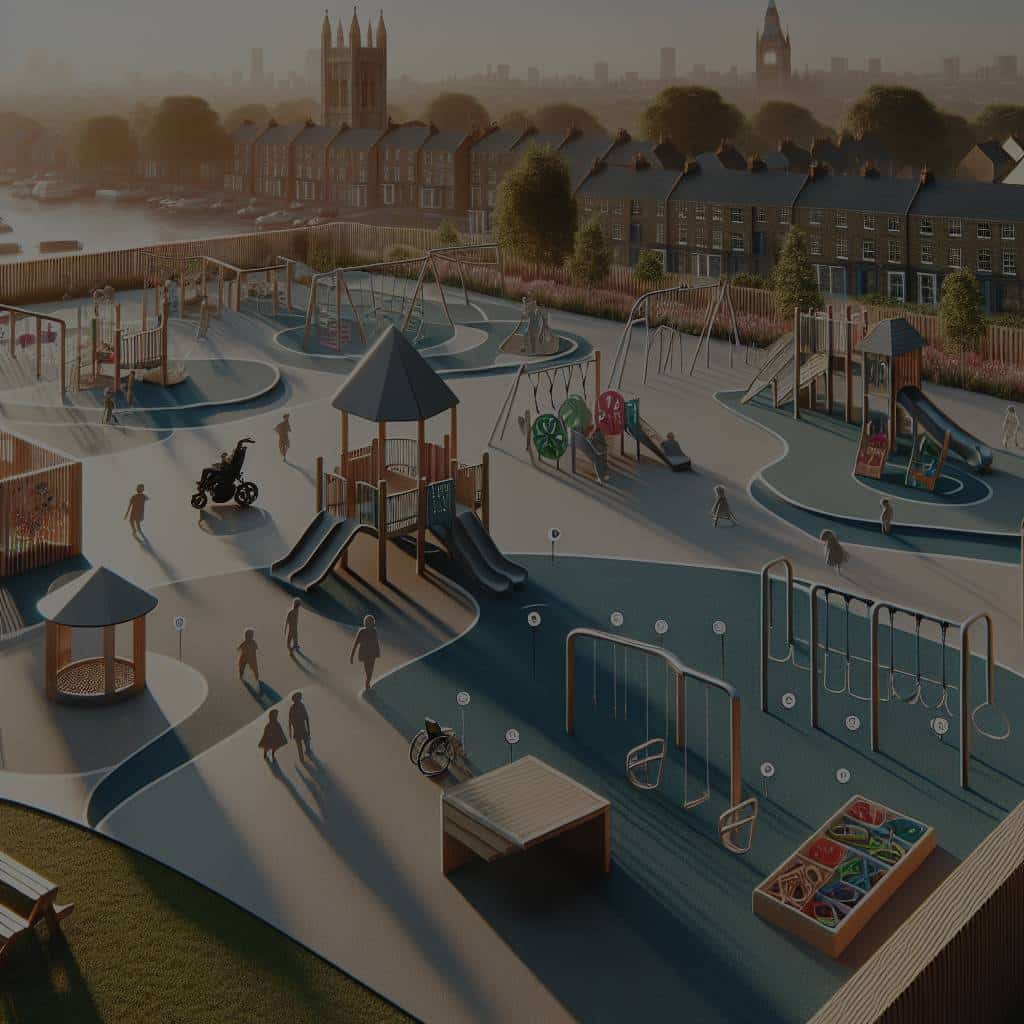How to Create an Inclusive Playground for Children with Disabilities in the UK?

Creating an inclusive playground that caters to all children in the UK, regardless of their abilities, is more than installing a ramp on a slide or adding a swing with a backrest. It requires a thoughtful approach that considers the full spectrum of children’s physical, sensory and social needs. This article will guide you on how to design a play space that is not only accessible but also offers children with disabilities the same opportunities for play and social development as their peers.
Understanding the Importance of Inclusive Play
The first step towards creating an inclusive playground is understanding why it’s crucial. Inclusive play refers to activities that children of all abilities can participate in. It’s about creating an environment that encourages interaction and engagement, and not just physical access. Inclusion goes beyond the physical.
A lire en complément : Moving to Portugal: a guide to finding accommodation
Inclusive playgrounds can be beneficial in several ways. They provide children with disabilities the opportunity to play and interact with other children, promoting social development. They can also improve physical health and sensory skills, providing a stimulating environment that accommodates various abilities. Furthermore, playgrounds that are inclusive break down barriers and foster acceptance among children, helping them to understand and appreciate diversity.
Considering the Design Elements
The design of an inclusive playground should be guided by the principle of universal design. This concept implies that the playground should be usable by all children to the greatest extent possible, without the need for adaptation or specialized design. It doesn’t mean that every piece of equipment must be accessible to every child, but rather the playground as a whole offers a range of play experiences accessible to children of all abilities.
A découvrir également : How to Incorporate Sustainable Fishing Practices in UK’s Seafood Cuisine?
There are several design elements to consider. First and foremost, the play equipment should cater to a variety of abilities. This might include swings with harnesses for children with weak muscle tone, sensory walls for those with sensory processing disorders, and wheelchair-accessible play structures.
Another critical design aspect is to ensure a clear line of sight for parents and carers. This helps them to keep an eye on their children without being overly protective or intrusive, encouraging independence for the child.
Choosing the Right Equipment
Investing in the right equipment for your inclusive playground is essential. The equipment should serve a broad range of abilities and provide various types of play, such as physical, sensory, and cognitive. For instance, swings with high backs and harnesses can provide physical support for children with disabilities. Tactile panels and musical instruments can serve children with sensory impairments.
Equipment that allows children to play at different levels, such as raised sandboxes or wheelchair-accessible merry-go-rounds, ensures that children of varying abilities have equal opportunities to participate. Beyond individual pieces of equipment, the overall layout of your playground should promote interaction between children of all abilities.
Incorporating Sensory and Social Elements
An inclusive playground should be a sensory-rich environment. It should incorporate elements that stimulate all the senses – sight, sound, touch, smell, and even taste. Sensory play can be particularly beneficial for children with sensory processing disorders, autism, or visual impairments.
Consider adding a sensory garden with a variety of plants to touch and smell. Incorporating elements like water play and sand play can also stimulate the senses. Musical instruments can provide auditory stimulation.
In addition to sensory elements, social interaction is a key part of an inclusive playground. Design your playground to promote cooperative play. This might mean including equipment that requires or encourages more than one child to operate, like a seesaw.
Collaborating with Your Local Community
Finally, creating an inclusive playground should be a community effort. Collaborate with your local community, including local schools, parent groups, and children themselves, to understand what they need and want from a playground.
You could conduct surveys or host community meetings to gather input. This helps ensure that your playground will be well-received and well-used by the local community. Incorporating feedback from children with disabilities and their parents can also help you understand their specific needs better, resulting in a more inclusive and effective playground design.
In conclusion, an inclusive playground can provide many benefits for children of all abilities, fostering social interaction, and promoting physical and sensory development. By understanding the importance of inclusive play, considering the design elements, choosing the right equipment, considering sensory and social elements, and collaborating with your local community, you can create a playground that truly welcomes all children.
Incorporating Inclusive Surfaces
Ensuring safety while promoting active play is an essential aspect of creating an inclusive playground. Inclusive surfacing is integral to the safety and accessibility of the playground. The surface has to be firm, stable, and slip-resistant, yet soft enough to cushion falls. This not only ensures safety but also facilitates movement for children with mobility aids like wheelchairs or walkers.
Traditional surfacing options like gravel or bark mulch are not suitable for inclusive playgrounds as they can be challenging to navigate for children using mobility aids. Therefore, surfacing materials such as poured-in-place rubber, rubber tiles, or artificial grass are good alternatives as they provide a smooth and shock-absorbing surface. These surfaces are also easy to maintain, which adds to the longevity of the playground.
In addition, it’s essential to consider the colour and texture of the surface. Bright colours can stimulate visual sensory needs, and different textures can stimulate tactile sensory needs. In other words, the playground surface can also contribute to the sensory play experiences of children.
Providing Adequate Shade and Seating
Creating an inclusive playground also means considering the comfort and needs of both the children at play and their caregivers. Providing ample shade and seating is a key factor to consider. Adequate shade not only provides relief from the sun but also extends the usability of the playground during hot summer months.
Shade structures can also double as play elements. For instance, a shaded sandpit or water play area can provide children with a cool place for sensory play. Natural shade from trees can also offer additional sensory elements like the rustling of leaves or the scent of flowers.
Seating areas should be strategically placed around the playground, offering a clear line of sight to the play area. This allows caregivers to supervise their children without being overly intrusive, fostering a sense of independence for the children. Seating areas should also be wheelchair accessible, allowing everyone to rest and socialise comfortably.
Conclusion
Creating an inclusive playground in the UK is more than just a checklist of accessible play equipment and safety measures. It’s about designing a play space that caters to the wide spectrum of children’s abilities and needs, providing equitable play opportunities for all. This requires an understanding and application of the principles of inclusive play and universal design.
Incorporating inclusive surfacing and adequate shade and seating contributes significantly to the safety, accessibility, and comfort of the playground. Remember, an inclusive playground is not merely a physical space but a social environment that fosters interaction, inclusion, and acceptance among children of all abilities. Therefore, local community collaboration becomes a crucial part of the design process, ensuring that the playground meets the unique needs and wants of its users.
Ultimately, an inclusive playground in the UK can serve as a beacon of diversity and inclusion, demonstrating how play spaces can be a catalyst for societal change. With careful planning and thoughtful design, we can create playgrounds where every child, regardless of their abilities, can play, explore, and learn side by side.
